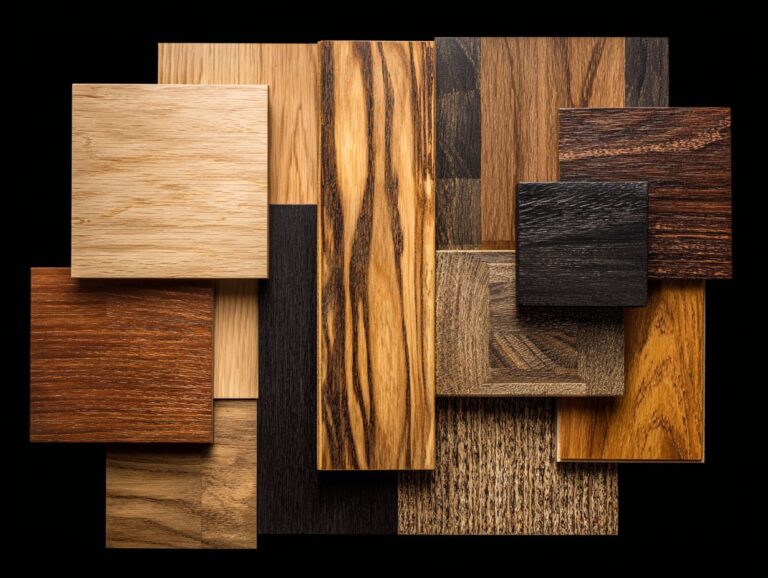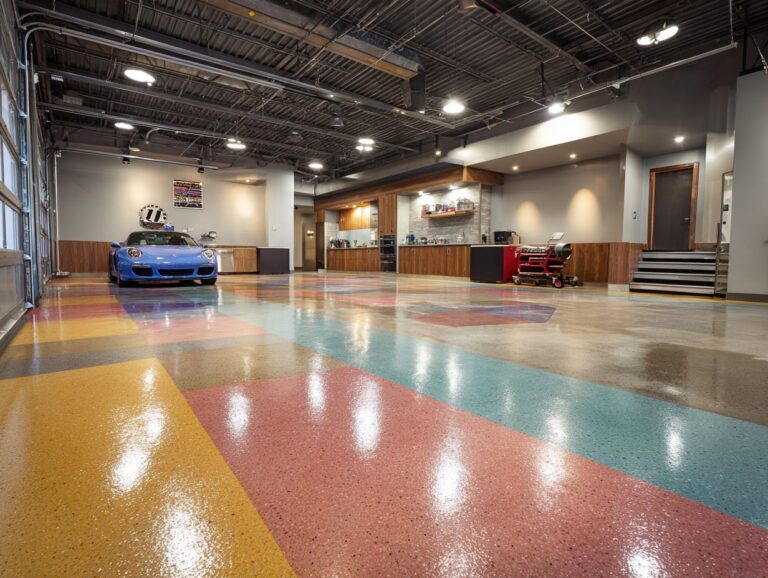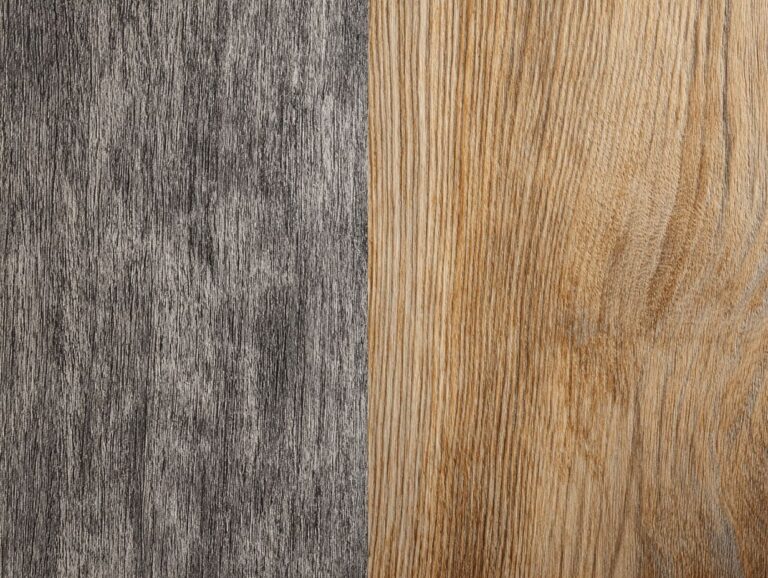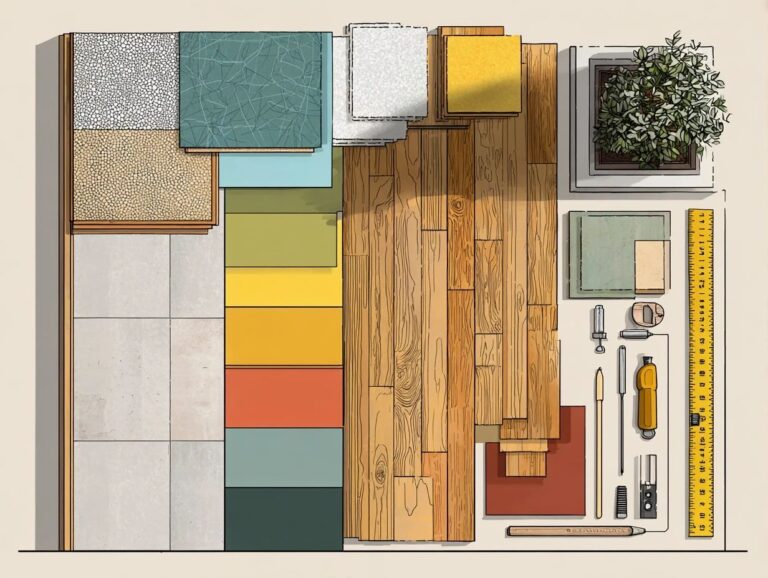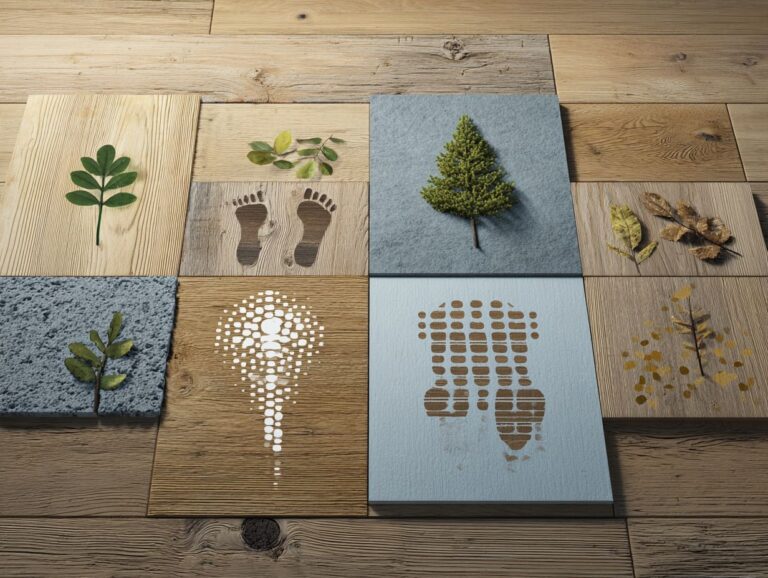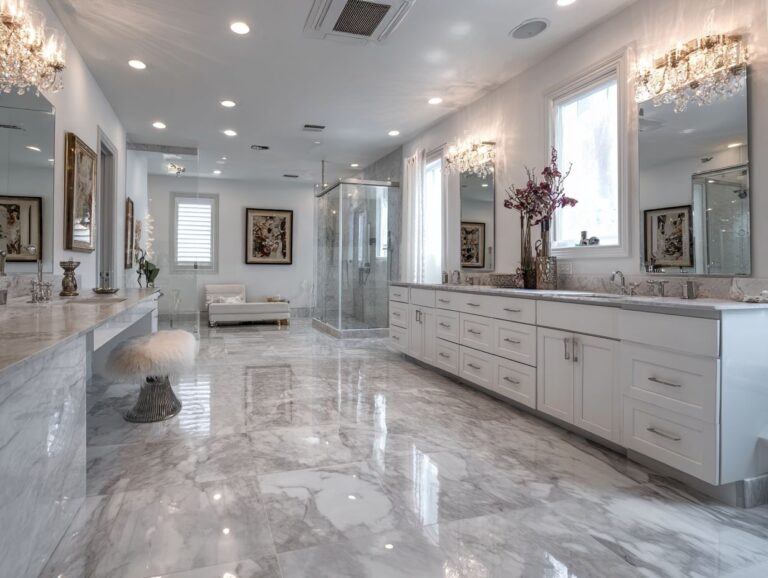Linoleum vs Vinyl – Understanding the Differences
When deciding between linoleum and vinyl flooring, knowing how they differ can affect how your home looks and works. While both options offer unique benefits, such as water resistance and ease of DIY installation, maintenance upkeep varies. Companies like Armstrong Flooring provide quality choices in both materials. In this article, we will look at the main differences, guiding you to choose the right option for your next flooring project.
Key Takeaways:
Contents
- Historical Background
- Composition and Materials
- Manufacturing Processes
- Durability and Longevity
- Maintenance and Care
- Cost Comparison
- Environmental Impact
- Linoleum and Vinyl Flooring Market Analysis
- Frequently Asked Questions
- What is the difference between linoleum and vinyl flooring?
- Which flooring option is more environmentally friendly?
- Is one type of flooring more durable than the other?
- Can linoleum or vinyl flooring be installed in moisture-prone areas?
- Which type of flooring is easier to clean and maintain?
- Is one type of flooring more budget-friendly than the other?
Definition of Linoleum
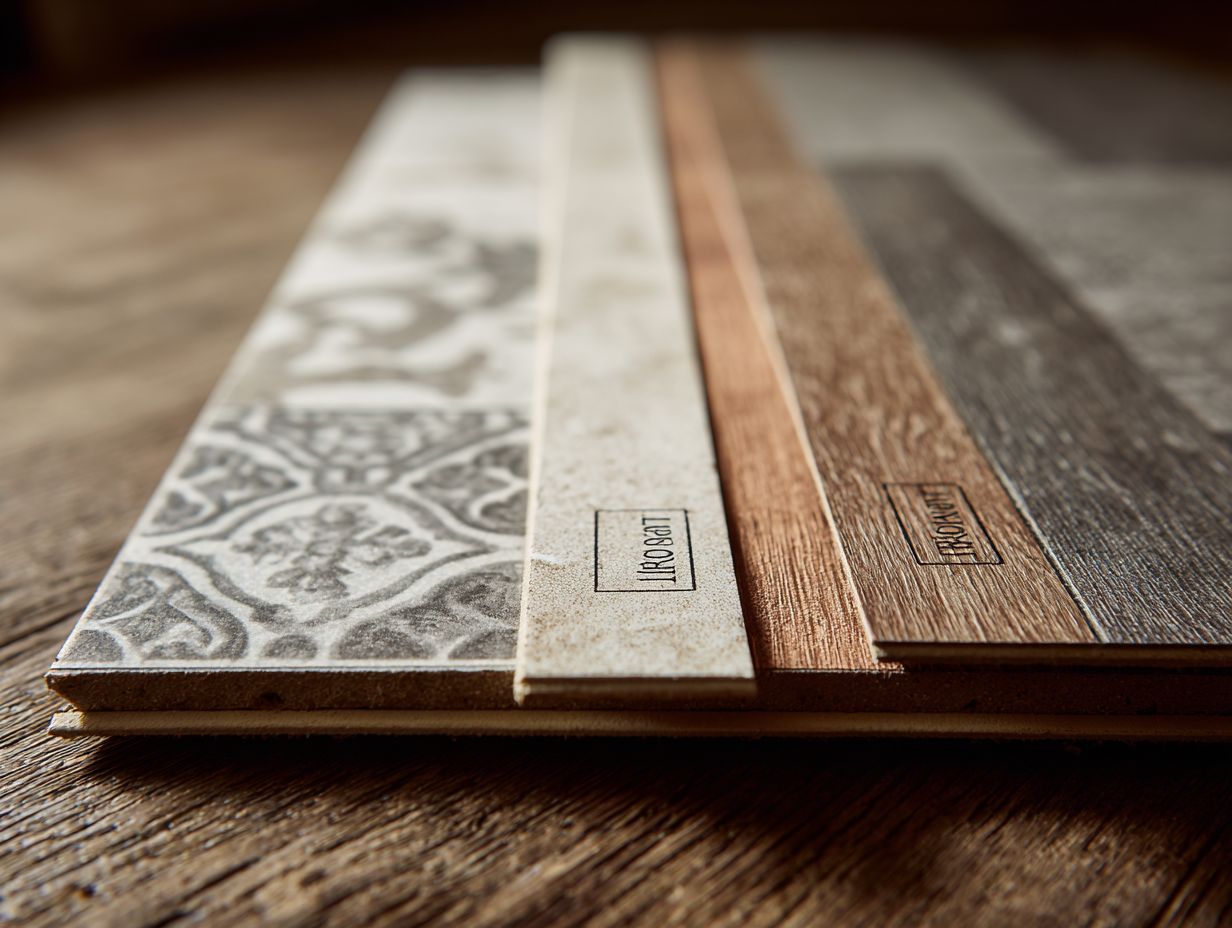
Linoleum, a sustainable flooring option made from natural materials like linseed oil and jute, offers both durability and an eco-friendly alternative to synthetic options.
This flooring is usually made from a blend of treated linseed oil, cork powder, wood dust, and natural colors. It breaks down naturally and has low levels of harmful chemicals.
A reputable brand, Armstrong Flooring, showcases linoleum as a top choice for homes, providing various colors and designs that mimic traditional flooring. Armstrong’s Marmoleum range, for instance, emphasizes durability while contributing to improved indoor air quality.
Consider installing linoleum in kitchens or high-traffic areas to take advantage of its resilience and sustainable credentials.
Definition of Vinyl
Vinyl flooring, often referred to as luxury vinyl, is a synthetic flooring product known for its durability, water resistance, and variety of design options.
This flooring is made up of three parts: the top layer, the pattern layer, and the bottom layer. It is durable and simple to care for.
It is ideal for both residential and commercial applications, commonly used in high-traffic areas like kitchens and offices.
Brands such as Murnane Floors offer extensive selections, providing choices in styles ranging from wood to tile appearances.
The simple click-lock installation makes it easy for people to quickly improve their homes and workplaces.
Historical Background
Linoleum and vinyl have been used for a long time, showing how they have changed from practical flooring to fashionable, current options used in many different ways.
History of Linoleum
Invented in the mid-19th century, linoleum became a popular flooring choice due to its durability and eco-friendly composition, steadily gaining traction in both homes and commercial spaces.
Significant milestones include the introduction of linoleum by Frederick Walton in 1860, who patented the product, setting the stage for widespread production. By the early 1900s, Armstrong Flooring emerged as a leader, contributing to linoleum’s popularity with innovative patterns and colors.
The mid-20th century saw linoleum becoming synonymous with modern design, with a resurgence in retro styles today highlighting its versatility. As more people look for eco-friendly materials, linoleum remains a stylish and environmentally-friendly choice.
History of Vinyl
Vinyl flooring came about in the early 1900s as a budget-friendly and flexible option for floors, quickly changing to satisfy the needs of people today.
Vinyl, first created as a substitute for linoleum, improved greatly in the 1940s with the development of bendable vinyl sheets, which simplified installation and upkeep.
The 1970s brought the first luxury vinyl tiles (LVT), which mimicked natural materials like wood and stone.
Vinyl flooring now uses modern technology, making it longer-lasting, resistant to water, and with surfaces that mimic real materials. Tools like the Vinyl Floor Installer app can help homeowners visualize their options, streamlining the selection process while ensuring a perfect fit for any space.
Composition and Materials
Knowing what makes up linoleum and vinyl is key to assessing how they perform, how long they last, and how to care for them. If interested in the core differences, you might find our discussion on WPC vs SPC vinyl flooring insightful.
Materials Used in Linoleum
Linoleum is primarily made from natural materials, including linseed oil, cork dust, and wood flour, contributing to its sustainability and eco-friendly credentials.
These components significantly influence the flooring’s durability and maintenance needs.
For example, linseed oil acts as a binder, enhancing flexibility and providing a water-resistant surface. Cork dust offers excellent shock absorption, reducing sound transmission, while wood flour contributes to the overall strength and aesthetic appeal of the flooring.
The presence of natural pigments allows for varied color options, ensuring a visually appealing finish without harsh chemicals. This blend creates a strong, simple-to-maintain floor that needs little care throughout its life.
Materials Used in Vinyl
Vinyl flooring is constructed from synthetic materials such as polyvinyl chloride (PVC), which provides water resistance and design versatility.
The structure of vinyl flooring typically consists of multiple layers, including a backing layer for stability, a design layer featuring printed patterns, and a wear layer that protects against scratches and stains.
Additives like stabilizers make the material last longer and protect it from UV light, so the colors stay bright. The quality of these components directly impacts the flooring’s appearance and maintenance costs; higher-quality products may reduce long-term cleaning and replacement expenses.
Cleaning the floor regularly with a wet mop and a mild cleaner keeps it looking good and in good condition over time.
Manufacturing Processes
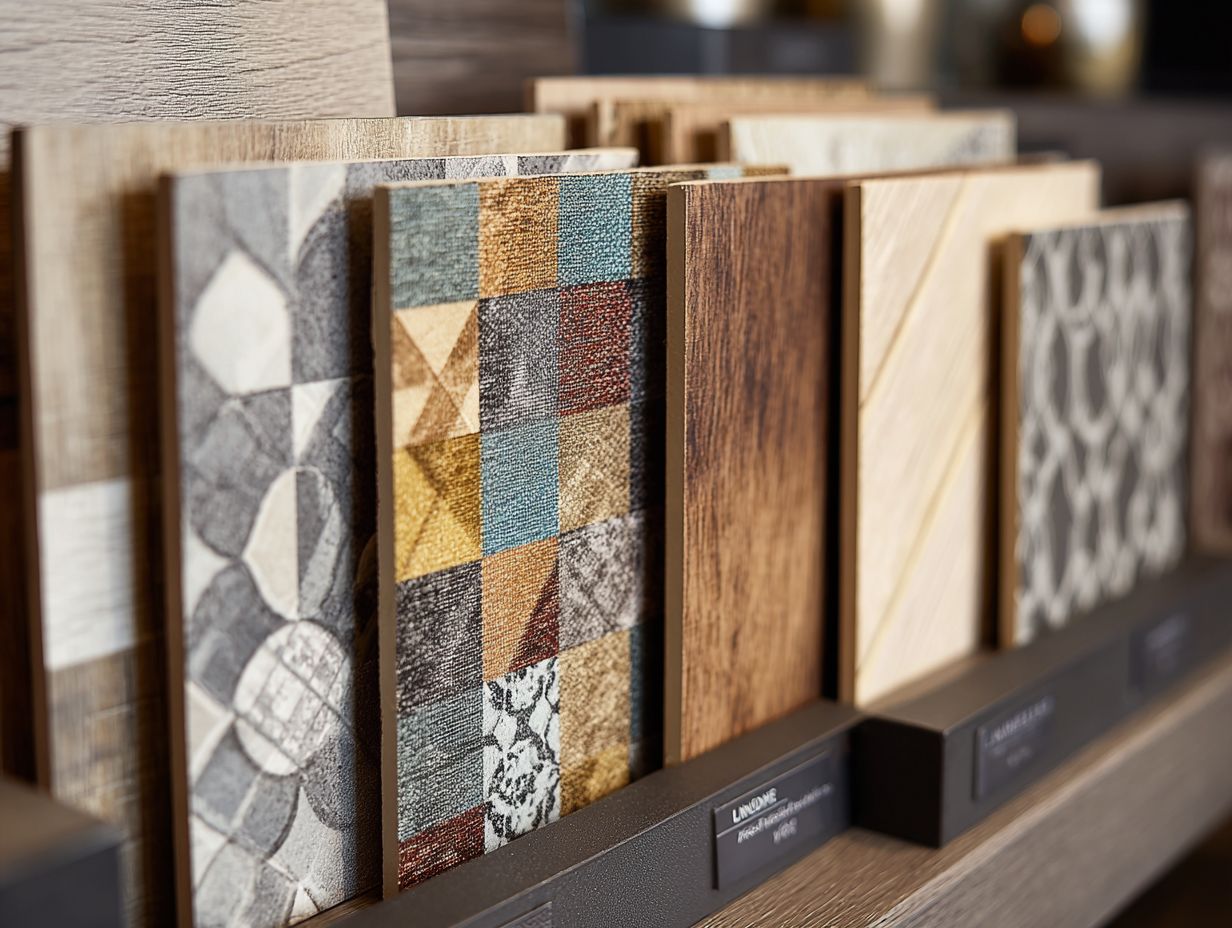
Linoleum and vinyl are made differently, which affects how they look, how long they last, and where they can be used. For an extensive analysis of similar manufacturing processes, our deep dive into high-pressure vs direct-pressure laminate manufacturing offers valuable insights.
How Linoleum is Made
Producing linoleum involves mixing natural materials, pressing them onto a support layer, and then allowing the product to cure for added strength and stability.
The process starts with sourcing renewable materials such as linseed oil, cork dust, and wood flour. These ingredients are blended to form a thick paste, which is then spread onto a jute or felt backing for added support.
To be environmentally friendly, manufacturers often use adhesives that dissolve in water and reduce energy use by using effective drying methods. Curing in controlled settings extends the life and improves the effectiveness of the final product.
By prioritizing these sustainable practices, linoleum maintains its reputation as a durable, biodegradable flooring option.
How Vinyl is Made
Vinyl flooring production requires a complex process of layering materials, heating, and pressing to create a resilient product designed for high moisture areas.
The manufacturing process typically begins with a base layer made from polyvinyl chloride (PVC), which provides durability.
Above this, a core layer is engineered for strength and can include additional materials like fiberglass, enhancing water resistance.
The upper layer, often made of clear protective material, stops scratches and stains, which is perfect for damp areas.
Once these layers are put together, they are heated and pressed, which makes the bond strong so each plank can handle daily use and resist moisture well.
Durability and Longevity
Checking how well linoleum and vinyl hold up over time is important for people looking for long-lasting options in busy areas. For those particularly interested in the durability aspects of vinyl, it’s worthwhile to explore the Vinyl Flooring Wear Layer – Thickness and Durability Guide, which provides in-depth insights into what makes vinyl a robust choice.
Durability of Linoleum
Linoleum can last 20-40 years with proper care, making it a durable choice for homes and businesses.
The durability of linoleum depends on its thickness and the quality of its materials. Opt for sheets that are at least 2.5mm thick for better wear resistance.
High-quality linoleum made from natural materials like linseed oil and cork dust tends to outperform lower-grade options. To keep the surface intact, quickly clean up any spills, use a cleaner that won’t harm the material, and regularly apply a sealant to guard against water damage.
Regular sweeping and occasional waxing can stop wear, keeping your linoleum looking good and lasting longer.
Durability of Vinyl
Vinyl flooring typically lasts 10 to 25 years, depending on its quality and type, making it a long-lasting choice for various applications.
Luxury vinyl, often found in residential settings, can last up to 25 years with proper care, thanks to its multi-layer construction. In contrast, commercial-grade vinyl, designed for high foot traffic, typically lasts 10-15 years but may exceed that with regular maintenance.
Factors like foot traffic intensity, proper cleaning procedures, and timely repairs significantly impact the lifespan of vinyl flooring.
For instance, using mats at entry points can help reduce wear, while regular sweeping and mopping with the appropriate cleaners will maintain the surface, extending its life considerably.
Maintenance and Care
To keep your floors in good condition for a long time, it’s important to take care of them correctly.
Linoleum and vinyl each need specific ways of cleaning to stay attractive and work well.
Caring for Linoleum
To care for linoleum, regular sweeping and occasional damp mopping are essential to prevent damage and maintain its eco-friendly surface.
Consider applying a linoleum-specific cleaner, such as Murphy Oil Soap, which safeguards the surface. Avoid harsh chemicals like bleach or ammonia, as they can degrade linoleum over time.
To take care of your flooring, put felt pads under furniture to avoid scratches. Regularly look for any collected moisture and clean up spills right away.
Use a linoleum sealant every few years to make it stronger and shinier, which helps it last longer and look nice.
Caring for Vinyl
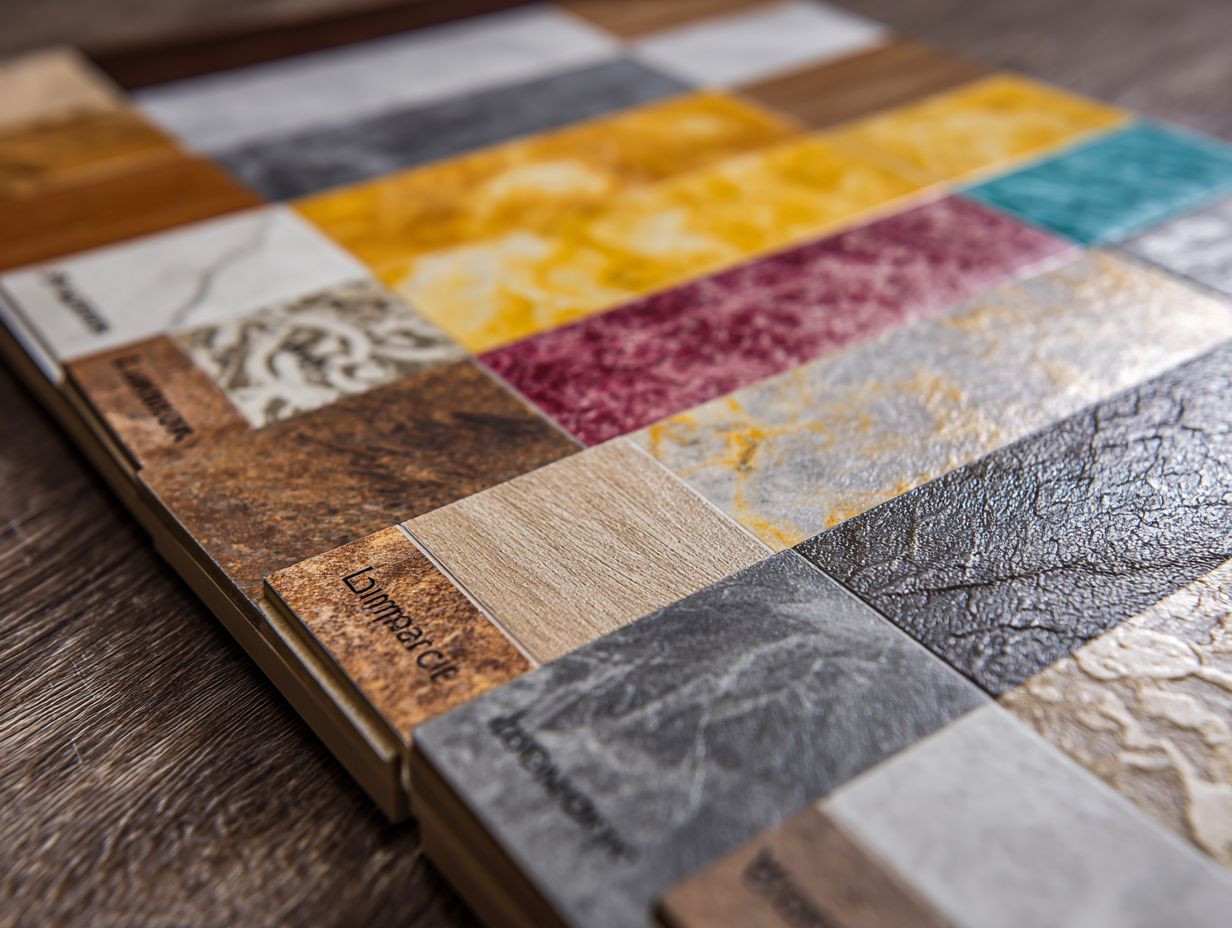
Vinyl needs regular maintenance, like sweeping and using particular cleaners, to maintain its look and keep it resistant to moisture.
To maintain vinyl flooring, use a pH-neutral cleaner, such as Bona Professional Series Hardwood Floor Cleaner, to avoid damaging the finish.
Regularly sweep or vacuum to remove grit that can cause scratches. Always damp-mop with a microfiber mop-avoid wet mopping, as excess water can seep into seams.
Common mistakes include using abrasive cleaners or steam mops, which can strip away the protective layer. By following these practices, you can significantly extend the life and beauty of your vinyl flooring.
Cost Comparison
Price is an important consideration when selecting flooring. Linoleum and vinyl have different upfront costs and offer varying long-term benefits.
Initial Costs of Linoleum
Linoleum usually costs between $2 and $6 per square foot based on the quality and brand, which makes it a budget-friendly choice.
Plus the material costs, consider installation expenses.
If you opt for a DIY approach, expect to spend about $200 on tools like a utility knife, straightedge, and adhesive. Professional installation usually costs between $1 to $3 per square foot, leading to a total from $300 to $600 for a 300-square-foot room.
Considering these options will help you decide if you can afford professional help or if doing it yourself better fits your needs and skills.
Initial Costs of Vinyl
Vinyl flooring usually costs between $1 and $5 per square foot. Luxury vinyl is more expensive because it is designed to be more durable and stylish.
Installation usually costs $2 to $5 per square foot, depending on where you live and the contractor’s skill.
For example, a 500 square foot room can cost between $1,500 and $2,500 for high-quality luxury vinyl, including both materials and installation.
Long-term value considerations include durability, as vinyl can last 10-20 years, and maintenance, which is minimal compared to other flooring options.
Vinyl might cost more initially, but it is durable and low-maintenance, making it a wise financial choice.
Environmental Impact
When choosing flooring, knowing the environmental effects of linoleum and vinyl is important for shoppers interested in eco-friendly options.
Linoleum and Vinyl Flooring Market Analysis
Linoleum and Vinyl Flooring Market Analysis
Market Growth and Size: Vinyl Flooring Market Growth
Market Growth and Size: Linoleum Market Growth
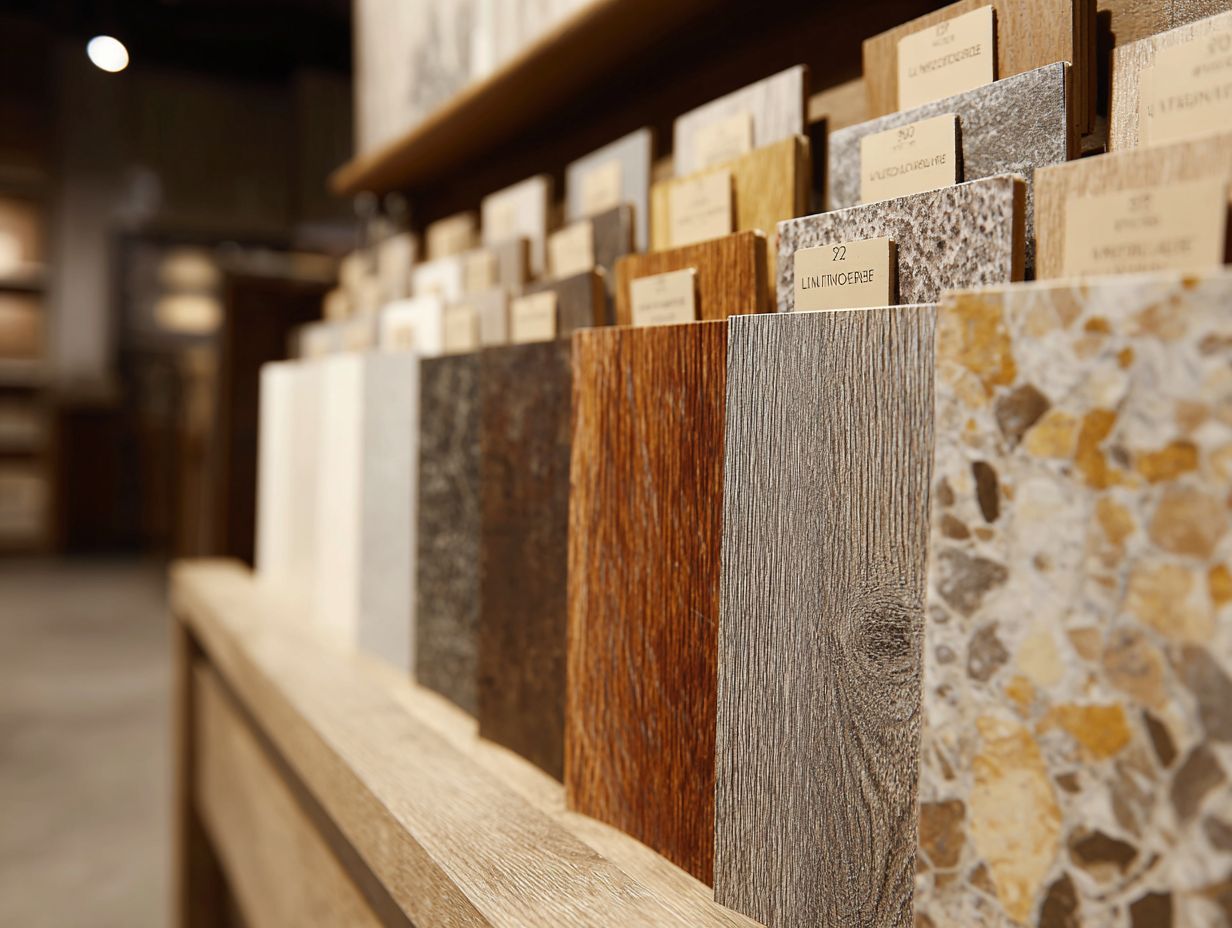
The Linoleum and Vinyl Flooring Market Analysis provides helpful details about how these popular flooring options will grow and become more common in the market. This review covers how fast these markets are growing, the share each region holds, and expected market sizes. It shows how both vinyl and linoleum flooring markets change over time.
The Vinyl Flooring Market is experiencing robust growth, with a Compound Annual Growth Rate (CAGR) of 6.8% from 2024 to 2032. The market size was valued at $36.63 billion in 2023 and is expected to reach $66.94 billion by 2032. This big increase is because vinyl flooring is flexible, long-lasting, and looks good, which makes it a popular choice for homes and businesses. The increasing trend towards urbanization and the popularity of home renovation projects further fuel this growth.
In contrast, the Linoleum Market shows a steady growth trajectory with a CAGR of 5.8% from 2023 to 2030. The market is notably driven by eco-conscious consumers, given linoleum’s biodegradable and sustainable properties. In 2023, the Asia Pacific region held a dominant 38% market share, reflecting the area’s rapid urban development and increasing construction activities. Meanwhile, North America accounted for a 26% market share, indicating a significant demand for eco-friendly flooring options in the region.
- Regional Market Share for Linoleum Flooring:
- The Asia Pacific region leads with a substantial 38% market share, driven by burgeoning infrastructure projects and the rise of sustainable building practices.
- Europe follows closely with a 28% market share, supported by stringent environmental regulations and the preference for sustainable construction materials.
- South America and the Middle East and Africa have smaller shares of 5% and 3% respectively, indicating potential growth opportunities as awareness and demand for sustainable flooring options increase.
The Linoleum and Vinyl Flooring Market Analysis Highlights the increasing need for these flooring types, due to their special benefits and the rising focus on eco-friendly building materials. As both markets keep expanding, there are plenty of chances for businesses to create new solutions and address the changing needs of environmentally aware customers and current building requirements.
Eco-friendliness of Linoleum
Linoleum is celebrated for its eco-friendliness, being made from biodegradable, renewable resources that have a minimal environmental footprint.
Its production involves natural materials such as linseed oil, cork dust, and wood flour, leading to a lower carbon footprint compared to synthetic flooring options.
Linoleum can be certified by organizations like the Forest Stewardship Council (FSC), ensuring sustainable sourcing. Lifecycle analyses reveal that linoleum lasts up to 40 years, reducing waste.
Importantly, it contributes to better indoor air quality, emitting fewer volatile organic compounds (VOCs) than vinyl alternatives. This makes linoleum a healthier choice for both homes and commercial spaces.
Eco-friendliness of Vinyl
While vinyl flooring offers durability, its environmental impact raises concerns, particularly regarding its synthetic materials and disposal processes.
Vinyl production involves polyvinyl chloride (PVC), which can release harmful chemicals. When discarded, vinyl contributes to landfill waste since it is non-biodegradable.
Innovations in eco-friendly vinyl are emerging. For instance, companies like Flooring for Good have started producing bio-based vinyl made from renewable resources.
Recycling initiatives are gaining traction; programs like Reclaimed Wood Exchange allow consumers to recycle old vinyl into new flooring products. By choosing eco-friendly options and participating in recycling programs, consumers can mitigate their environmental impact.
Frequently Asked Questions
What is the difference between linoleum and vinyl flooring?
Linoleum and vinyl flooring are both popular choices for residential and commercial spaces, but they are made from different materials. Linoleum is made from natural materials like linseed oil, cork dust, and wood flour, while vinyl flooring is made from synthetic materials like polyvinyl chloride (PVC).
Which flooring option is more environmentally friendly?
Linoleum is considered a more environmentally friendly option because it is made from natural and renewable materials. Vinyl, on the other hand, is made from non-renewable resources and can emit volatile organic compounds (VOCs) during production and installation.
Is one type of flooring more durable than the other?
In general, linoleum is more durable than vinyl flooring. Linoleum is recognized for its durability, making it a common option for places with a lot of foot traffic. But if you take care of them, both types of flooring can last for many years.
Can linoleum or vinyl flooring be installed in moisture-prone areas?
Linoleum is more resistant to moisture than vinyl flooring, as it is not affected by water. Vinyl flooring, on the other hand, can be susceptible to water damage if not properly sealed. It is important to choose the right type of flooring for areas prone to moisture.
Which type of flooring is easier to clean and maintain?
Both linoleum and vinyl flooring are relatively easy to clean and maintain. However, linoleum stands up better to scratches and stains, making it a good option for busy areas. Vinyl flooring may require more frequent cleaning and maintenance to keep it looking its best.
Is one type of flooring more budget-friendly than the other?
Vinyl flooring usually costs less than linoleum, so it’s a favorite for shoppers looking to save money. However, consider how durable the flooring is and how long it will last to make a wise investment for your space over time.
